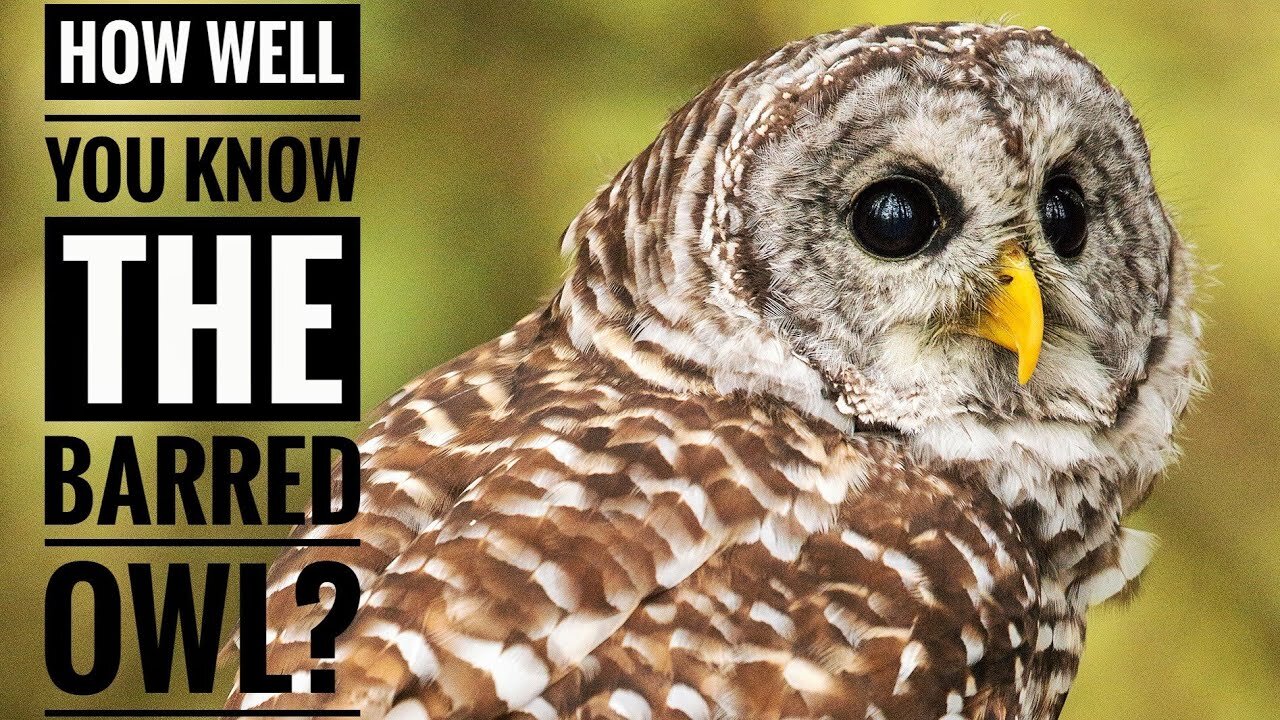Premium Only Content

Barred Owl || Description, Characteristics and Facts!
Barred Owl Description:
The Barred Owl (Strix varia) is a striking and charismatic bird of prey native to North America. Recognized for its distinctive appearance and haunting vocalizations, this medium-sized owl is a captivating species.
Characteristics:
Plumage: The Barred Owl features a distinctive barred pattern on its feathers, consisting of alternating dark and light bands, which provides excellent camouflage in its woodland habitat.
Size: With a wingspan of around 3.3 to 3.8 feet (1 to 1.2 meters) and a length of 16 to 25 inches (40 to 63 centimeters), the Barred Owl is a medium-sized owl.
Facial Disk: Its facial disk, a defining characteristic of owls, aids in sound localization during hunting. The facial disk is framed by a ruff of feathers, adding to the owl's overall allure.
Eyes: Large, dark brown eyes contribute to its keen nocturnal vision, allowing it to hunt effectively in low-light conditions.
Habitat: Barred Owls are adaptable and can be found in various wooded environments, including forests, swamps, and urban areas, demonstrating their versatility in habitat selection.
Diet: These owls are opportunistic hunters, preying on small mammals like mice, voles, and rabbits. They are also known to consume birds, amphibians, and invertebrates.
Vocalizations: The Barred Owl is famous for its distinctive hooting calls, often described as sounding like, "Who cooks for you? Who cooks for you all?" These vocalizations are a prominent feature of their communication.
Facts:
Barred Owls do not build their own nests. They typically utilize abandoned nests of other large birds or natural tree cavities.
These owls are known for their territorial nature and may exhibit aggressive behavior when defending their nesting sites.
Barred Owls are skilled in silent flight, thanks to the specialized structure of their feathers that reduces noise during flight, aiding them in surprising their prey.
They are capable of turning their heads up to 270 degrees due to their flexible neck structure, allowing for an extensive field of vision.
Hashtags:
#BarredOwl #BirdsOfPrey #WildlifeWednesday #NaturePhotography #OwlLovers #NocturnalWonders #Birdwatching #Conservation #HootHoot #NatureFacts
-
 LIVE
LIVE
Akademiks
4 hours agoDiddy Last Stance! Bail Hearing Live! Lil Durk Case update! Young Thug not getting back his SH*T?
4,534 watching -
 DVR
DVR
In The Litter Box w/ Jewels & Catturd
21 hours agoLegacy media CANNOT be trusted | In the Litter Box w/ Jewels & Catturd – Ep. 697 – 11/22/2024
21.7K13 -
 1:22:02
1:22:02
The Quartering
3 hours agoTrump BEATS NYC Felony Charges, New Woke Car Ads, WW3 Updates & More
59K35 -
 10:03
10:03
Colion Noir
3 hours agoKimber's First "True" Double Stack 1911 Isn't Just A Gun It's A Statement
9.45K9 -
 1:46:28
1:46:28
vivafrei
6 hours agoKeir Starmer Goes Full Tyrant! Canada Goes Full Gestapo! Trump Picks & MORE! Viva Frei Live
67.8K26 -
 LIVE
LIVE
ThatWhiteFish (Gaming)
2 hours ago $3.02 earnedNew to the Franchise! Can we survive? Do you have rations?
416 watching -
 1:10:50
1:10:50
The New American
2 hours agoIs The Deep State Trying to Trigger WW3 Before Trump Takes Office? | The New American Daily
13.9K7 -
 51:36
51:36
PMG
15 hours ago $4.10 earned"Hannah Faulkner and Sophia Lorey | FIRST AMENDMENT VIOLATED"
27K5 -
 LIVE
LIVE
Flexarot
3 hours agoGetting The Bansho Fan & Crane Level Capped! (Dragon Ball Online Galaxy)
125 watching -
 1:17:57
1:17:57
Russell Brand
4 hours agoLara Logan EXPOSES the Media's Hidden Agendas & Power Plays – SF499
125K189